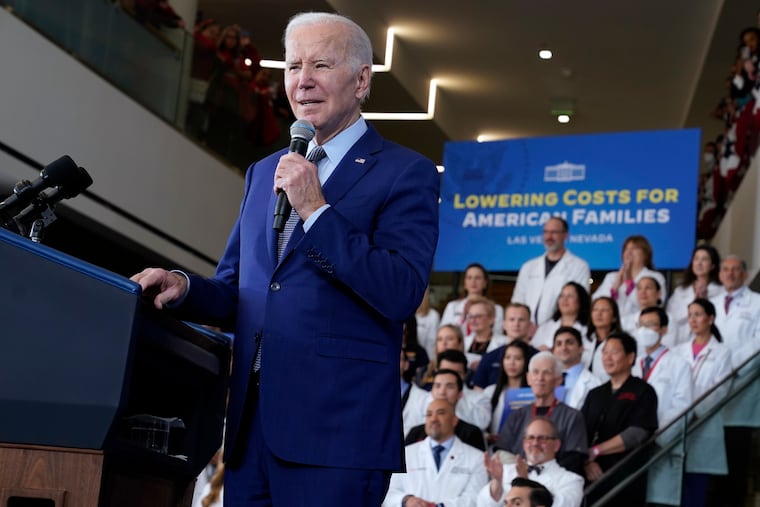Universities, including Penn, say Biden tactic to lower drug prices may stifle innovation
The University of Pennsylvania, the University City Science Center, and others warned that the federal proposal could dampen investor interest in licensing faculty inventions.

The University of Pennsylvania and top research universities nationwide say a Biden administration proposal could make it harder, and possibly less lucrative, to license faculty inventions developed with government funding for research.
The change is part of President Joe Biden’s push to reduce prescription drug costs, including his widely watched plan for Medicare to negotiate prices with pharmaceutical manufacturers for the first time.
A less publicized effort centers on the federal government’s major role in paying for basic scientific research. A proposed change in regulatory guidance would make clear that high prices could be a factor in deciding to license taxpayer-funded drug patents to generic manufacturers as a way to cut drug prices it considers “unreasonable.”
Prescription drug prices were 2.78 times higher in the United States in 2022 than in other comparable countries, Rand, a nonprofit research organization, reported in February.
Top research universities nationwide, including Penn, have in public comments decried the proposed change.
Penn says the new guidance would stifle commercialization efforts that have made the Philadelphia region a strong player in the development of new cell and gene therapies. Penn scientists developed a technology underlying the most common COVID-19 vaccines, resulting in more than a $1 billion in royalties for the university from licensing agreements.
The proposal is already complicating negotiations with companies interested in licensing Penn inventions, the university said.
» READ MORE: How Penn’s chief innovation officer helps turn faculty research into a multibillion-dollar windfall
Small impact expected
If the change goes into effect, the tactic would work only for a small number of drugs, according to research by professors at Stanford and Arizona State published in March by the National Bureau of Economic Research.
That’s because all the patents on a drug have to be based on government-funded research for federal regulators to have so-called march-in rights to license patents to a generic manufacturer. That’s rarely the case.
Only 2.5% of the 883 new drugs the FDA approved from 1985 to 2022 are based only on public-sector patents, Stanford Law School’s Lisa Larrimore Ouellette and Arizona State’s Bhaven N. Sampat wrote. That totals just 22 drugs in nearly four decades.
“While the new march-in rules could be a tool to lower prices for a few drugs, their overall impact on prices or expenditures will likely be limited,” they wrote.
The researchers cited a high-cost prostate cancer treatment as a rare example of high-cost drug developed exclusively through taxpayer-funded research. The drug costs as much as $190,000 a year. Even so, the National Institutes of Health in March rejected a petition to license the three Xtandi patents to a generic manufacturer, because the treatment is widely available.
Still, the threat of march-in rights at times has led to voluntary, isolated price reductions, according to Knowledge Ecology International, a nonprofit research group that focuses on public health, competition, and other issues.
Ouellette and Sampat did not include biopharmaceutical treatments, which are disproportionately represented among high-cost drugs, because little public information on those patents is available, the authors said. Those treatments typically have even more patents, making the public-sector patents an even smaller segment, they said.
The Bayh-Dole Act
Congress passed the Bayh-Dole Act in 1980 out of concern that not enough taxpayer-funded research was reaching the market. The law allowed universities and other contractors to keep patent rights on inventions created with government support and license them to companies that wanted to market them for profit.
The law also allowed the government to grant licenses on its own under certain circumstances by exercising its march-in rights. These circumstances include when the invention was not being used in a reasonable amount of time or the government identified an unmet health or safety need, according to a February summary of the law and proposed guidance change by the Congressional Research Service.
The law did not mention drug pricing considerations. And the government has never exercised its march-in rights.
The proposed guidance would make clear that agencies could consider price as a factor in deciding whether the government should exercise march-in rights. If the guidance goes into effect it would not carry as much legal weight as formal regulations, the Congressional Research Service said.
Penn’s Jan. 31 comment said the proposed change is already having an impact on negotiations with companies that want to license inventions by Penn scientists. They are asking for “unacceptable ironclad guarantees” the results of company-funded R&D will not be subject to federal march-in rights, Penn said.
Some will steer clear of technologies that had federal support, the letter said.
Despite such warnings by Penn and research universities, the Arizona State and Stanford researchers said no one knows how much impact it would have if price were a factor in the use of march-in rights.
Ouellette and Sampat wrote: “Would commercialization rates drop 1%? 50%? Not at all? Over 40 years after Bayh-Dole’s enactment, we don’t know.”